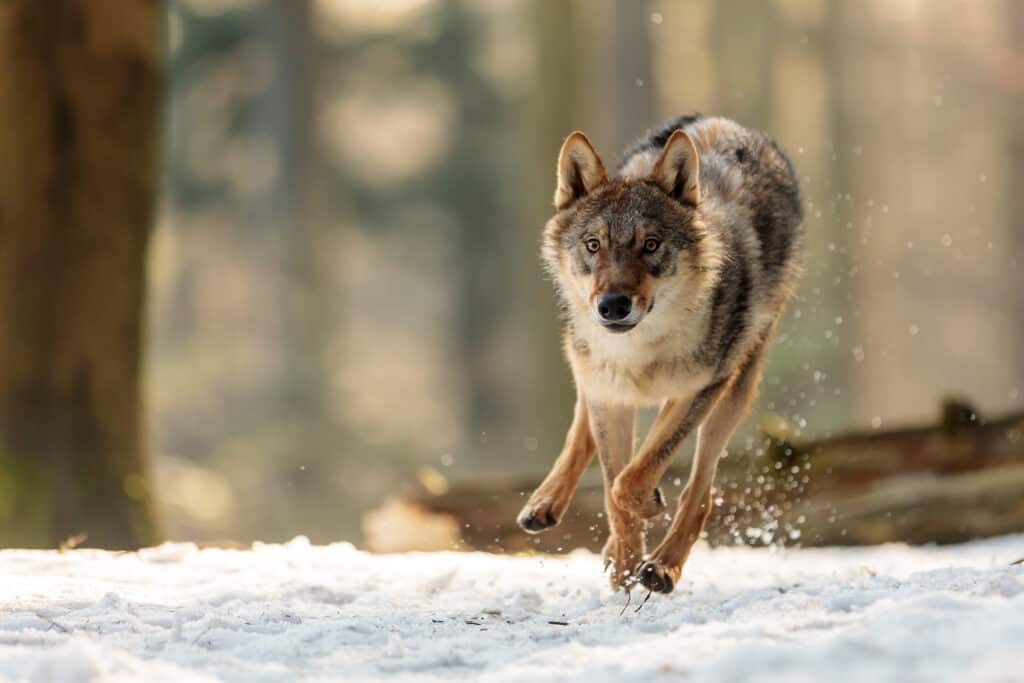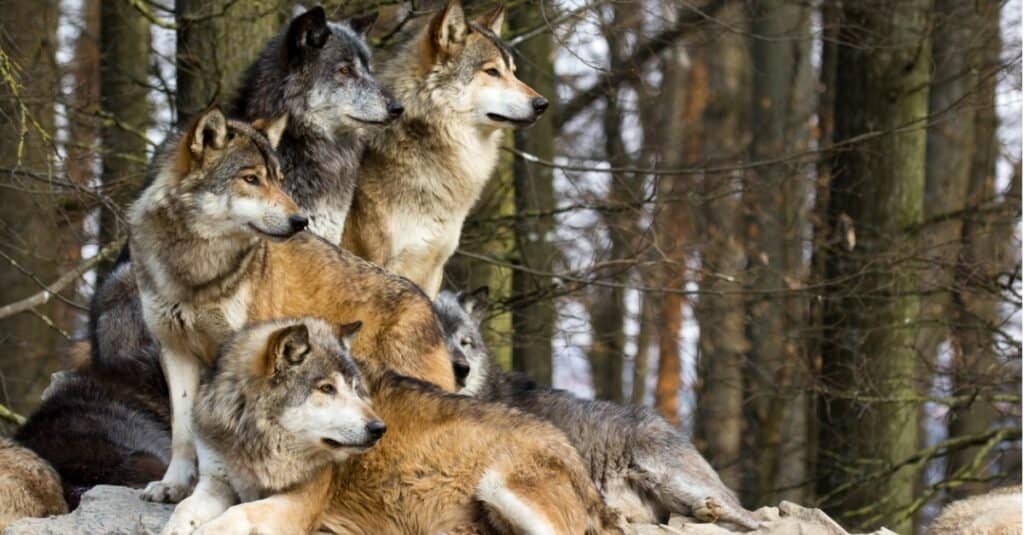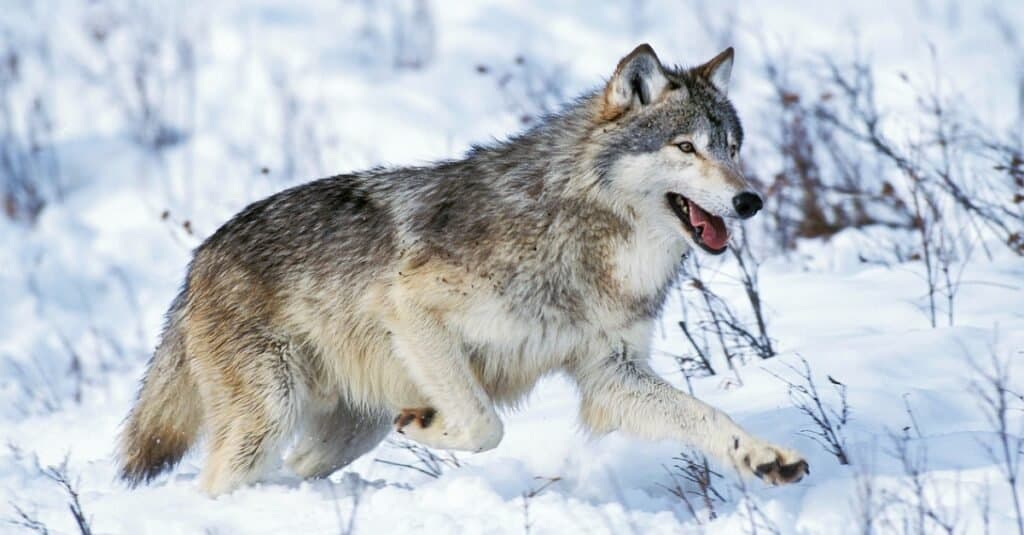What can run 35 mph and has 42 sharp teeth? A wolf!
Gray wolves have a bite force of around 400 psi, which means they can bite through bone. These agile canine predators can take down large prey like moose, bison, elk, and caribou.
Wolves tend to avoid humans. However, conflict from misinformation and livestock predation can cause attacks to happen. There are also rare cases of lone wolves acting out of the norm and targeting humans as easy prey.
Would you know what to do if you came face-to-face with a wild wolf? This article will tell you everything you need to know about handling a wolf encounter. So, keep reading to learn how to prevent a wolf attack from happening and how to survive a world encounter.
How to Survive a Wolf Encounter: Wolf Identification Tips

Grey wolves are vicious and fast animals.
©AB Photographie/Shutterstock.com
How can you know you’re looking at a wolf, not a wild dog or coyote? Wolves are much bigger than other canines.
Gray wolves can reach up to 6 feet in length and 30 inches tall (at shoulder height). Females are slightly smaller than males, weighing 75 to 80 pounds. Whereas males usually weigh closer to 100 pounds.
Size is just the start. You can also identify wolves by their fur coat. The coat color varies between black, white, gray, and brown shades.
Another way to distinguish gray wolves from coyotes is by looking at their tails and ears. Wolves have short bushy tails and short rounded ears. Finally, a wolf’s mussel is much bigger and less pointed.
How to Survive a Wolf Encounter: Spotting Wolf Tracks
Noticing wolf tracks is a great way to prevent an attack. Once you see a track, study its length and width. A wolf track will be around 4 inches wide and 5 inches long.
Wolves have symmetrical toes and big claws, so look for these traits in the tracks. Coyotes have much smaller tracks and are usually less direct than a wolf’s. While coyotes meander down the trail, wolves walk with direct intentions. They take a direct, purposeful route to get from one spot to the next.
How Dangerous Are Wolves?

Wolves are speedy animals that can exceed 30 MPH.
©Michal Ninger/Shutterstock.com
Are wolves dangerous? Wolves don’t go out of their way to attack people. They’re shy animals that try to avoid contact with humans. That’s why overall, wolves aren’t dangerous to us; we aren’t on their daily menu! That being said, wolves are powerful creatures. If a wolf wants to hurt a person, that individual better know what to do next.
Wolves are fast, smart, and relentless. Once they start going after their prey, escaping is nearly impossible. Since they travel in packs, encountering one dangerous wolf likely means dealing with several. While humans are usually safe during a wolf encounter(except in certain situations), pets are always on the menu.
Will a Wolf Hurt My Dog?
How dangerous are wolves to pets? Extremely. These large carnivores are notorious for killing domestic dogs. Since wolves are territorial, they view roaming dogs as competitors. If the dog reaches a spot where a wolf made a recent kill, the wolf may kill the dog to defend its food. Since wolves avoid residential areas, domestic dogs are generally safe.
If you’re taking your dog hiking or hunting with you, keep your eyes peeled for signs of wolf activity. Wolf howls, tracks, and scat are just a few red flags that you’re entering wolf territory. Keeping your dog on a leash or under strict voice control is a good idea.
If you hear wolf howls, it’s time to get to safety. Fun fact; a wolf’s howl tells other wolves a lot of information. A single howl can reveal a wolf’s location, status, and intention.
Where Wolves Live
A few places you’re likely to encounter a wolf include California, Montana, Wyoming, Wisconsin, Alaska, Oregon, Idaho, and Minnesota. You can also find wolf populations throughout North Carolina, New Mexico, and Alaska. Avoiding a wolf attack is much better than having to escape one. If you’re hiking in an area with wolf activity, travel in a group to lessen the risk of an encounter.
Wolf attacks are rare, especially with the canine population declining. Did you know there are only around 300,000 wolves left in the world? Wolves used to thrive throughout the northern hemisphere. But habitat destruction has severely limited their range and numbers. They currently inhabit about 10% of their former habitat due to land development.
How to Prevent a Wolf Attack
Good news! Wolves don’t want to attack you. These impressive predators aren’t naturally aggressive toward humans. Wolf attacks are one of the rarest of all large predator attacks. Since wolves are usually afraid of people, there’s a lot you can do to de-escalate things during an encounter. There are also things you can do to minimize your chances of seeing wolves in the wild.
To discourage wolves from your campsite, keep things nice and clean. Avoid leaving food out or dumping leftovers by the fire. Don’t leave unwashed pots and pans around the campsite either. Any food you plan on keeping needs to be in animal-proof containers. If you have garbage, keep it secured. You shouldn’t bury the garbage, but rather secure it and pack it out. If you’re camping with pets, don’t let them roam away from the campsite.
If you’re going hiking, travel in a group. Small children should always be close to adults. The odds of a predatory wolf choosing a child are rare. But it’s better to play it safe. Keep noise makers on hand, and be vigilant for signs of wolf activity. Again, these can include tracks, howls, and scat.
Never approach a dead animal carcass in the woods. This could be a fresh wolf kill, and approaching it may trigger an attack. Finally, stay away if you see a wolf kill, rendevous site, or den.
How to Survive a Wolf Encounter

Wolves are apex predators, meaning they’re at the top of the food chain.
©iStock.com/Cloudtail_the_Snow_Leopard
When you see a wolf, remain calm. Wolves don’t see humans as prey. There’s a good chance the wolf will flee the second it gets a chance. Even a pack of wolves is more likely to attack an animal than a human. Compared to moose and bears, wolves are much less likely to attack people. So if you see a wolf in the wild, keep your distance. Carefully retreat to a safe spot if you can. If you’re in the middle of the woods, stay still and let the wolf leave the area first.
How to Handle a Wolf That Isn’t Afraid of People
What if you see a wolf that isn’t afraid of people? An approaching wolf is a scary situation. What you do next will determine if a scary situation turns deadly.
When a wolf approaches, stand your ground, throw things at it, and be loud. An approaching wolf isn’t necessarily aggressive. However, it’s still a dangerous situation.
Sometimes people feed wolves, and they lose their fear of humans. If a wolf is approaching you, it might be food conditioned. It’ll expect a handout and can become aggressive if it doesn’t get one. Even if it does get food, an attack is likely. Any wolf that isn’t naturally afraid of people is a threat. Wolves that aren’t afraid of people are also more likely to have rabies.
How to Survive a Wolf Encounter: Scare Away a Wolf
The moment the wolf starts approaching you, start scare tactics. Go all out and be as loud as you can. Do not let that wolf get close to you. The closer it gets to you, the more likely an attack will happen. Distance is your friend; keep that wolf far away from you.
Wave your arms around, throw rocks, scream; the crazier and more intimidating you are, the better. If you’re in a group, work together to yell at the wolf while throwing things at it. You need to send a clear message to the wolf that it’s not wanted.
Be loud and wild. Scare an approaching wolf away as soon as you can. You’re probably dealing with an aggressive wolf if they keep approaching. An aggressive wolf encounter is one of the most dangerous situations to have on your hands.
What if You Encounter an Aggressive Wolf?
An aggressive wolf has you in its sight. Even though you’re screaming and throwing things, the predator continues to advance. What do you do?
You have a couple of options. You can slowly walk backward while clapping your hands and making noises. If the wolf stops following, continue your slow retreat.
Always stare directly at the wolf. Turning your back on any aggressive canine is never a wise move. If you have someone with you, stand back to back. Act aggressive. Be scary and loud. But move slowly. As you move, try retreating as far away as possible.
Another tactic is to lunge toward the aggressive wolf while making noise. You can yell and clap your hands or use noise makers. Lunging towards the wolf might scare it away, but it’s dangerous because it could also trigger an attack.
How to Defend Yourself Against a Wolf
Predatory wolves usually become submissive when animals assert their dominance. If a wolf thinks you’ll be easy to attack, prove them wrong. Making yourself look big and intimidating is your best chance of survival.
If you have bear spray or pepper spray, use it! Prepare yourself by practicing retrieving the spray ahead of time. As you hike, keep the bear spray in an easy-to-reach area, like a holster.
If you have any viable weapon, prepare to use it. This could be a ski pole, hatchet, or even a tent pole. Use whatever objects you have to put between yourself and the wolf. Even holding your sunglasses out like a weapon can intimidate the wolf. You need to make the wolf question whether or not it should attack. Being loud and waving an object or weapon around is a great start.
If the wolf makes contact, go all out. Fight back with everything you have. An unarmed human isn’t going to beat a wolf in a fight. But the more aggressively you protest, the more likely the wolf will retreat.
Some outdoor enthusiasts suggest making your hand into a fist and shoving it down the wolf’s throat. The idea is that if the wolf can’t breathe, it’ll end its attack. But there isn’t any proof of this method.
Climb a Tree
Wolves can’t climb trees. Climbing a tree is wise if you’re alone on a hike and have nowhere else to go. The downside is that a pack of wolves will be content to wait by the tree for a while. You might find yourself up the tree for hours. But resting on a branch is better than becoming a wolf snack.
How Wolves Fight
Wolves are apex predators and sit at the top of the food chain. Knowing how these canines hunt prey can give you an advantage in the wild. The more you know about the wolf’s predatory tactics, the safer you’ll be!
Wolves are ambush predators. They rely on surprise to take down all sorts of prey.
Wolves hunt in a pack. The pack will spread out and surround its prey. They like to test their prey to see if there are any weaknesses.
When it’s time to attack, different wolves will go after different parts of the prey. While some members approach from the rear, others grab the prey by its nose. Wolves are skilled at blocking attacks and countering with bites to the extremities.
What Else Should You Know About Wolves?

Gray wolves are considered elegant predators and highly social animals that form tight, nuclear packs.
©iStock.com/slowmotiongli
Wolves mainly eat meat. They enjoy eating elk, caribou, bison, deer, and other hoofed animals. Oftentimes, wolves hunt prey that’s much larger than they are. That’s why it’s common for wolves to hunt and live in groups. Along with large prey, wolves also fast on fish, snakes, mice, rabbits, and other animals.
In the movies, when a wolf pack is about to attack, the members growl and snarl at the prey. This doesn’t happen in the real world. Wolves snarl and growl when they’re about to fight another wolf, not when they’re about to enjoy a meal. That’d be like you yelling at a delicious cheese pizza before taking a bite; it just wouldn’t make sense.
When a wolf is about to eat its prey, they appear happy and friendly. They wag their tails, their ears are up, and they’re quiet. If a pack of wolves seems happy, they’re likely about to eat. So remember, happy wolves aren’t safe wolves — they’re just hungry!
How Common Are Wolf Attacks?
Wolf attacks are rare. There have been less than 500 wolf attacks over the last 20 years. There are four different types of wolf attacks. The four kinds of wolf attacks are:
- Provoked
- Predatory
- Rabid
- Aggressive
A provoked attack is a wolf acting in defense. Predatory attacks happen when a wolf attacks humans as food. This usually only happens with sick wolves. Rabid wolves are one of the most common offenders of wild wolf attacks. Finally, someone walking too close to a den site may encounter an aggressive wolf attack.
Wolf Attacks Family Camping in Canada
Wolf attacks are rare, but they do happen. One wolf chose to attack a family camping at a national park in Canada. The Rispoli family was camping in Banff National park when a wild wolf attacked their campsite in the middle of the night.
The wild wolf began dragging the father of the family by his leg. The man fought back aggressively, and a nearby camper came to help. The entire family survived the ordeal, and officials think the wolf may have been sick. When a wolf is in poor condition, it’s more likely to attack people as a food source.
Know How to Survive a Wolf Attack
There you have it! The top tips for preventing, escaping and surviving a wolf encounter or attack. Knowing how to survive a wolf encounter is all about understanding animal behavior. How you handle a wolf attack is much different than how you’d handle a grizzly bear attack.
Since wolves are generally afraid of people, making noise is one of your best defenses. If the wolf continues to approach, use your bear spray and throw objects at it.
There’s a good chance you’ll be able to scare the wolf off or slowly retreat to safety. Just make sure you don’t run! Remember, wolves can easily outrun deer, so humans don’t stand a chance on foot. Running also puts your back to the wolf, and that’s never a good idea.
During a wolf encounter, you must stand your ground, maintain eye contact, and be intimidating. If you’re traveling with small children, pick them up immediately, and keep your pets nearby.
Encountering a wild wolf doesn’t have to be a deadly situation. Give the wolf plenty of space and let them go on about their day. Never feed a wild wolf, and if you have to, climb a tree! Wolves can’t climb trees, so getting up high can be a good way to stay safe.
Up Next
- Meet the World’s Deadliest Wolf to Ever Live (Killed 11 Children)
- See Incredible Up Close Footage of A Wolf in Yellowstone
- Watch an Entire Wolf Pack Descend on a Trespassing Grizzly
The photo featured at the top of this post is © AB Photographie/Shutterstock.com
Thank you for reading! Have some feedback for us? Contact the AZ Animals editorial team.






